Everything You Need to Know About Employment Verification Letters
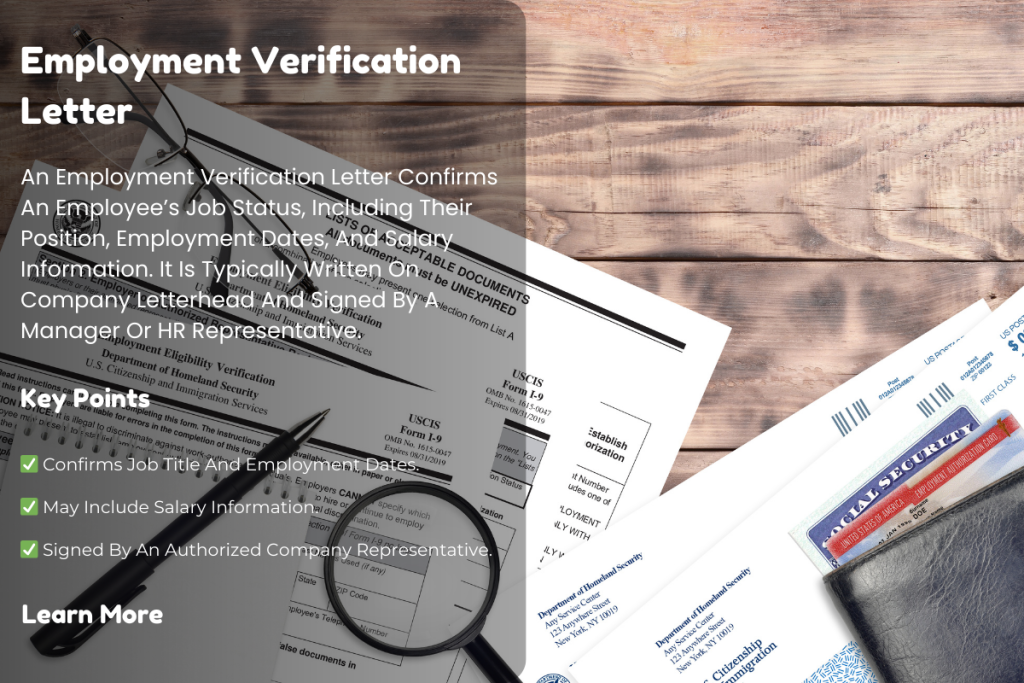
What Does An Employment Verification Letter Look Like?
An employment verification letter is an official document issued by an employer to confirm certain details about an employee’s job status. This letter serves as evidence that an individual is currently employed with a specific company and typically includes essential details such as job title, length of employment, and salary information (if applicable). Employment verification letters are commonly requested by external entities such as banks, landlords, government agencies, and prospective employers for a variety of purposes.
In this article, we’ll explore what an employment verification letter looks like, why it’s important, and the key components that should be included in the document. We’ll also walk you through the best practices for creating a detailed, accurate, and professional letter, as well as provide useful examples to help guide you in writing one yourself.
Understanding The Purpose Of An Employment Verification Letter
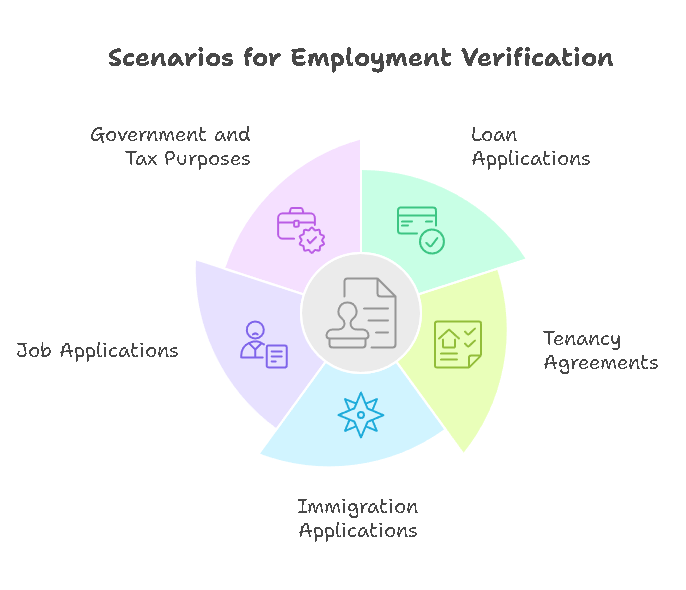
The primary purpose of an employment verification letter is to confirm an individual’s employment details to a third party. This could be a financial institution, a potential landlord, or even a government agency. These entities often require verification to assess the employee’s financial reliability, job stability, or eligibility for specific programs such as loans or visa applications.
Here are some common scenarios where an employment verification letter might be required:
- Loan Applications: Financial institutions may require proof of employment when a person applies for a mortgage, car loan, personal loan, or other types of credit. The lender wants to ensure that the applicant has a stable source of income to repay the loan.
- Tenancy and Rental Agreements: Landlords or property management companies may ask for an employment verification letter when renting a property. This helps the landlord determine if the potential tenant has a reliable income to cover the rent.
- Immigration Applications: When applying for a visa, work permit, or residency, proof of employment may be required to demonstrate financial stability and an individual’s ties to their home country. Government agencies typically request employment verification as part of their approval process.
- Job Applications: When a person is applying for a new job, potential employers may request an employment verification letter to confirm the candidate’s previous employment history, job title, and experience. This helps the employer verify the authenticity of the applicant’s resume or job application.
- Government and Tax Purposes: Some government agencies, such as the Social Security Administration or tax authorities, may require proof of employment to determine eligibility for benefits or tax filings.
Why Employment Verification Letters Are Important
Employment verification letters are vital for maintaining transparency and trust between the employee, employer, and the requesting party. They ensure that both the employer and employee provide accurate information about the employee’s job status. Furthermore, these letters can help prevent any misunderstandings, fraud, or misrepresentation of employment details.
- Accurate Verification: The letter serves as a clear and formal statement of employment, helping verify claims made by the employee.
- Facilitates Trust: For third parties such as landlords, financial institutions, or government agencies, the letter establishes trust that the employee can meet certain financial or professional obligations.
- Legal Protection: An employment verification letter offers legal protection to both the employer and the employee, as it helps clarify terms of employment in case of disputes or investigations.
Key Components of An Employment Verification Letter
For an employment verification letter to be effective and professionally acceptable, it should include several important components. These elements help ensure that the letter serves its intended purpose and provides all necessary information for the requesting party.
Here are the key elements that should be included in an employment verification letter:
- Employer’s Contact Information:
The letter should begin with the employer’s name, company name, and contact details (address, phone number, and email). This allows the recipient to easily reach the employer if they require further verification. - Employee’s Details:
The letter should clearly state the employee’s full name and job title. It should also specify the dates the employee began working at the company and, if applicable, the end date of their employment (if the person is no longer with the company). Some letters also mention the employee’s department or division, particularly if the employee holds a specialized role. - Job Title and Responsibilities:
It’s essential to specify the employee’s job title and a brief description of their job responsibilities. This helps the third party understand the employee’s role within the company and the level of responsibility they carry. For example, a letter might state, “John Doe works as a Senior Financial Analyst in the Finance Department.” - Employment Dates:
The employment start date and, if applicable, the end date should be clearly mentioned. This establishes the duration of the employee’s tenure with the company. If the individual is still employed, the letter should state “currently employed” along with the start date. - Salary and Compensation Details (If Applicable):
In some cases, particularly for loan applications or rental agreements, the salary details may be necessary. The letter should clearly state the employee’s salary, hourly wage, or commission details, depending on the payment structure. The letter should mention if the salary is annual or monthly. - Purpose of the Letter:
The letter should include a statement about the purpose for which the employment verification is being issued. This could include phrases like “this letter is issued for the purpose of confirming the employment status of [Employee’s Name] for [specific purpose].” - Employer’s Signature:
The letter should end with the signature of the authorized person in the company—usually a human resources representative, manager, or the company president. The signature adds authenticity to the letter and serves as formal validation from the employer. - Date of Issue:
It’s important to include the date on which the letter is issued. This helps the third party determine if the employment details are up-to-date, especially in situations where there may be significant time between employment and verification.
Employment Verification Letter Template
Below is an example of an employment verification letter presented in a clear table format for easy understanding. The table breaks down the components of the letter and demonstrates how to customize it for different purposes.
| Section | Details |
|---|---|
| Employer’s Contact Information | [Employer’s Company Name], [Address], [Phone Number], [Email Address] |
| Date | [Insert Date of Issue] |
| Recipient’s Name and Contact | [Recipient’s Full Name], [Recipient’s Address] |
| Subject | Employment Verification for [Employee’s Name] |
| Introduction | This letter serves to verify that [Employee’s Name] is employed with [Company Name] since [Start Date]. |
| Employee’s Details | [Employee’s Full Name], [Job Title], [Department], [Employment Dates] |
| Job Responsibilities | [Short Description of Employee’s Key Responsibilities] |
| Salary Details (if applicable) | [Employee’s Salary], [Salary Frequency, e.g., Annual/Monthly], or [Hourly Rate] (If necessary) |
| Purpose of the Letter | This letter is being issued for the purpose of [state the reason: e.g., loan application, rental agreement]. |
| Employer’s Signature | [Authorized Signatory Name], [Title], [Company Contact Information] |
| Closing Statement | Should you need further verification, please contact [Company Name] at [Contact Info]. |
Creating and Customizing Employment Verification Letters
Creating an employment verification letter requires attention to detail, clarity, and professionalism. Whether you’re an HR representative preparing a verification letter for an employee or a person looking to request one, understanding the process of writing and customizing the letter is essential. In this section, we’ll provide a step-by-step guide on how to create a well-structured employment verification letter, outline common scenarios where such letters are needed, and provide useful examples for different purposes.
Step-by-Step Guide to Writing an Employment Verification Letter
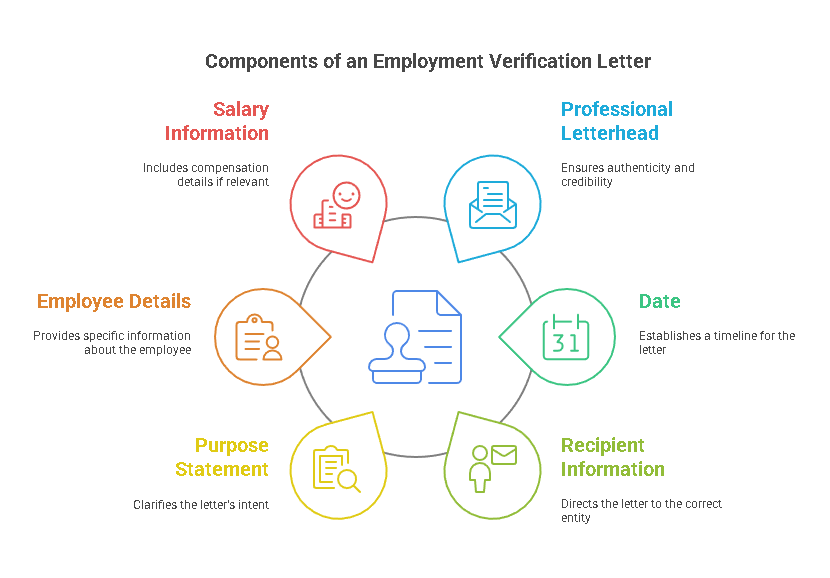
Creating an employment verification letter requires careful attention to detail. Whether it’s for a loan application, renting a property, or confirming job history, accuracy is crucial. Here’s a guide to help you create an employment verification letter that covers all the necessary information and follows proper business etiquette.
1. Use Professional Letterhead or Company Format
If the letter is coming from an organization, it’s essential to use official company letterhead. This includes the company name, logo, and address. Using letterhead adds authenticity and credibility to the letter, showing that it is a formal document coming directly from the employer. If your company doesn’t have a letterhead, make sure to include the company name and contact information at the top of the letter.
2. Include the Date
The date is a critical component of an employment verification letter, as it helps establish a timeline. The letter should be dated on the day it is issued, which ensures that the information provided is current and up-to-date.
3. Recipient Information
Include the name and address of the person or organization receiving the letter. If it’s for a specific purpose like a loan application or rental verification, be sure to include the name of the financial institution, landlord, or agency, along with their contact information. This ensures the letter is directed to the correct entity.
4. State the Purpose of the Letter
Clearly state the purpose of the letter in the introduction. For instance, you can begin with, “This letter serves as confirmation of the employment of [Employee’s Name] for the purpose of [loan application, tenancy agreement, etc.].” Being clear from the beginning will allow the recipient to understand the context of the letter.
5. Provide Detailed Information About the Employee
The bulk of the letter will be dedicated to the employee’s information. Include the following details:
- Employee’s Full Name: Include the complete name of the employee.
- Job Title and Department: Mention the employee’s job title and the department they work in.
- Employment Dates: Specify when the employee started working with the company. If they’re still employed, mention “currently employed” and the start date. If they’ve left the company, include the end date of their employment.
- Job Responsibilities: Depending on the request, you may want to include a brief summary of the employee’s role or key duties.
6. Salary Information (If Relevant)
In certain cases, especially for loan applications or rental verifications, the salary or compensation details of the employee may be required. Include the employee’s annual or monthly salary, hourly rate, or wage (depending on the request). If you’re not comfortable providing specific salary details, you may only include confirmation of employment status.
7. Closing the Letter
At the end of the letter, it’s important to provide the contact details of the person issuing the letter. This could be the HR manager, supervisor, or any authorized representative. This allows the recipient to follow up or verify the details if necessary. Provide the name, job title, and contact information of the individual who signed the letter.
8. Signature
The letter should end with the signature of the authorized representative from the company. This adds authenticity and makes the letter official. Below the signature, include the printed name and job title of the signatory.
Common Scenarios for Employment Verification Letters
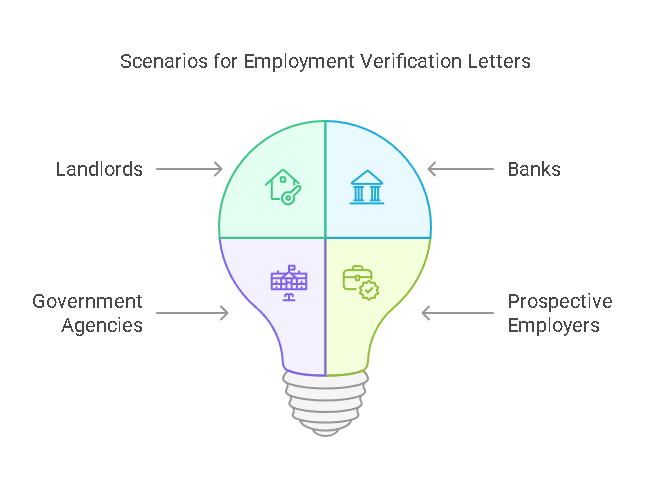
Employment verification letters are needed in various situations. Here are some common scenarios where such letters might be required, and how to customize them accordingly:
1. For Landlords or Property Management Companies
When applying to rent a property, landlords often request an employment verification letter to ensure that the tenant has a reliable income. The letter should confirm the employee’s job title, length of employment, and income level. It may also be helpful to include the employee’s job stability, especially if they’ve been employed with the company for an extended period.
2. For Banks and Financial Institutions
When applying for a loan or mortgage, the bank may ask for an employment verification letter to confirm the applicant’s employment status and income. In this case, the letter should include details such as the employee’s salary, job title, and length of employment. The bank wants to ensure that the applicant has a steady income to make loan payments.
3. For Government Agencies
Government agencies may require employment verification letters for various reasons, such as determining eligibility for certain benefits or processing immigration applications. These letters should include detailed job information and, in some cases, income verification. It is crucial to ensure that the information provided is accurate and aligns with the specific requirements of the agency.
4. For Prospective Employers
Prospective employers may request an employment verification letter to verify the candidate’s past employment history. This letter should confirm the candidate’s job title, duration of employment, and responsibilities. It is important to note that some employers may only provide a basic letter verifying employment dates and job title, while others may provide a more detailed description of the employee’s performance.
Examples of Employment Verification Letters
Below are two examples of employment verification letters, tailored to different purposes. These templates can be modified based on the specifics of the request.
Example 1: Employment Verification Letter for Tenancy
| Section | Details |
|---|---|
| Employer’s Name and Contact | XYZ Corporation, 123 Business Avenue, City, State, ZIP, (555) 123-4567 |
| Date | [Insert Date of Issue] |
| Recipient’s Name | [Landlord’s Name or Property Management Company] |
| Subject | Employment Verification for [Employee’s Name] |
| Introduction | This letter is to verify that [Employee’s Name] is employed at XYZ Corporation, located at [Business Address], for the purpose of renting a property. |
| Employee’s Details | [Employee’s Full Name], [Job Title], [Department], [Employment Dates: Start Date – Present] |
| Salary Details | [Employee’s Salary] (monthly/annual salary) or [Hourly Rate] |
| Closing | Should you need further verification, please contact [Employer Name] at [Phone Number or Email Address]. |
| Employer’s Signature | [Authorized Person’s Name], [Job Title], [Contact Information] |
Example 2: Employment Verification Letter for Loan Application
| Section | Details |
|---|---|
| Employer’s Name and Contact | ABC Finance Corp., 456 Corporate Blvd, City, State, ZIP, (555) 987-6543 |
| Date | [Insert Date of Issue] |
| Recipient’s Name | [Bank’s Name] |
| Subject | Employment Verification for [Employee’s Name] |
| Introduction | This letter serves as verification that [Employee’s Name] is currently employed at ABC Finance Corp. |
| Employee’s Details | [Employee’s Full Name], [Job Title], [Employment Dates], [Department] |
| Salary Details | [Annual Salary or Hourly Wage] |
| Purpose of Letter | This letter is being issued for the purpose of verifying employment for a loan application. |
| Employer’s Signature | [Authorized Person’s Name], [Job Title], [Contact Information] |
Mentioning Precisehire for Professional Verification Services
For businesses and individuals looking to streamline the employment verification process, Precisehire offers professional verification services. These services ensure that all employment verification letters are accurate, timely, and compliant with regulations. Whether you’re a business looking to verify employee information or an individual needing a reliable source for your employment details, Precisehire provides quick, accurate, and efficient verification services.
Legal Aspects, FAQs, and Conclusion
In this final section, we’ll delve into the legal aspects of employment verification letters, provide answers to frequently asked questions, and summarize the key takeaways. It is essential to understand the legal responsibilities of employers when issuing these letters and ensure that all information is accurate and compliant with privacy laws.
Legal Aspects of Employment Verification Letters
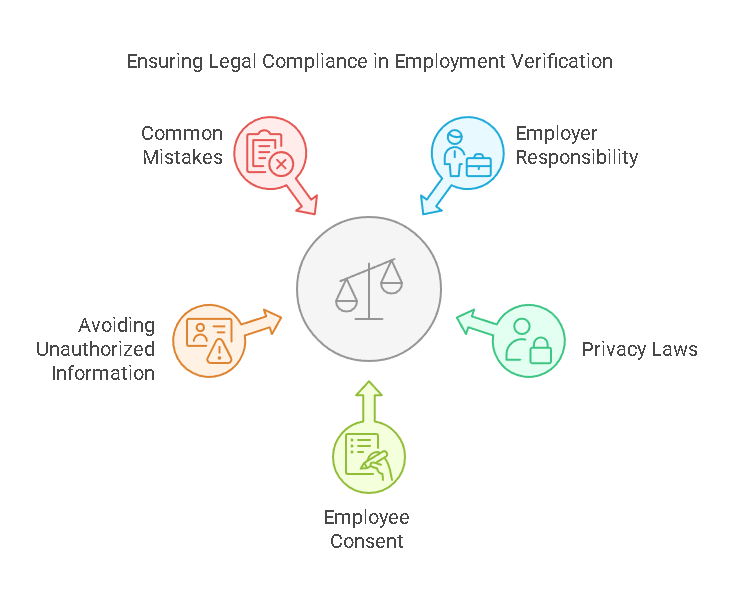
Employment verification letters, while generally straightforward, carry legal implications for both the employer and the employee. Employers must exercise caution and follow legal guidelines when providing these letters to avoid any liability. Here’s what employers need to know:
1. Legal Responsibility of Employers
Employers have a legal obligation to provide truthful and accurate information in employment verification letters. Misrepresenting an employee’s job title, salary, or employment dates can result in legal consequences, especially if the letter is used in situations like loan applications, immigration processing, or employment references. Therefore, employers must ensure the information is up-to-date, correct, and not misleading.
2. Compliance with Privacy Laws
Employees have the right to privacy, and employers must comply with privacy laws when sharing personal and employment-related information. In many countries, including the United States, the release of such information is governed by laws like the Fair Credit Reporting Act (FCRA) or the General Data Protection Regulation (GDPR) in the European Union. These laws mandate that employers obtain consent from the employee before releasing personal or sensitive details, especially if the information could affect the employee’s financial situation or immigration status.
3. Employee Consent
Before issuing an employment verification letter, it is essential to obtain written consent from the employee. This consent grants the employer permission to disclose specific employment details to third parties, such as banks, landlords, or government agencies. The consent should specify the purpose of the verification and the details that will be shared, ensuring both parties are clear about the information being disclosed.
4. What Not to Include
When providing an employment verification letter, employers must avoid including unnecessary or unauthorized information. For example:
- Personal information: Avoid disclosing personal details, such as the employee’s age, race, or family status, unless specifically required for legal reasons.
- Performance issues: It’s essential not to include any subjective information about the employee’s performance or conduct unless explicitly requested.
- Unauthorized salary or compensation data: Be mindful of sharing compensation details unless specifically required by the request. Some organizations may ask for salary history, but the employer can choose not to disclose this unless it’s necessary.
5. Common Mistakes to Avoid
- Including incorrect dates of employment or job titles. Double-check these details to ensure they are accurate.
- Failing to obtain employee consent. Always secure written approval before sharing employment details with third parties.
- Over-sharing personal details. Stick to job-related information unless the employee has agreed to disclose more.
FAQs: Detailed Answers to Common Questions
What information should be included in an employment verification letter?
An employment verification letter should include the employee’s full name, job title, dates of employment (start and end date, if applicable), salary or wage information (if necessary), and the purpose for which the letter is being issued. Additional details may be included based on the request, such as a summary of job duties or other relevant information.
Can I request my own employment verification letter?
Yes, employees can request an employment verification letter from their employer. Employers are typically willing to provide one when requested, as long as the request complies with company policies and privacy laws. It’s important to specify the purpose for which the letter is needed.
How long does it take to get an employment verification letter?
The timeline for receiving an employment verification letter varies depending on the company and the urgency of the request. In general, it may take anywhere from a few business days to a couple of weeks for an employer to process and issue the letter. It’s advisable to provide sufficient time for the employer to prepare the letter.
What should I do if there’s a mistake in my employment verification letter?
If there’s an error in your employment verification letter, notify the issuer immediately. The employer should issue a corrected version of the letter. It’s important to address errors as soon as possible, especially if the letter is being used for official purposes like a loan application or immigration.
Is an employment verification letter legally binding?
An employment verification letter is generally not legally binding in terms of contractual obligations. However, it is a formal document used to verify employment details. In cases where the letter contains inaccurate or false information, legal consequences may arise, especially if the letter is used to make decisions regarding financial transactions or government applications.
Conclusion
In conclusion, employment verification letters are vital tools for confirming employment details, serving various purposes such as loan applications, renting properties, and verifying job history for prospective employers. It’s essential to create a professional, accurate, and legally compliant verification letter that includes the correct information, follows privacy laws, and avoids unnecessary details.
By understanding the legal responsibilities, best practices, and common scenarios for issuing employment verification letters, both employers and employees can ensure that the process runs smoothly. For businesses and individuals who require efficient and reliable employment verification services, Precisehire offers professional verification services, helping to ensure that employment details are confirmed accurately and quickly.
Whether you’re an HR professional creating these letters or an employee requesting one, knowing how to write and customize an employment verification letter is crucial for ensuring accuracy and avoiding any potential issues.
